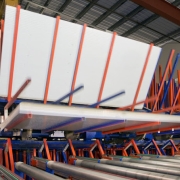Last summer, the acronym RAAC was launched into the spotlight overnight.
Reinforced autoclaved aerated concrete suddenly appeared on every news channel and at the top of the agenda of every staff meeting, days or hours before the start of the new school term in September 2023. Most commonly found on ceilings, wall panels and floors, RAAC was a remanent of brutalist industrialism from the 60s and 70s; buildings were being built quickly and contractors had to choose materials that were readily available and cost effective.
Accompanying the media attention was an obvious and urgent need for an emergency response to ensure pupils remained in face-to-face learning. Schools and Trusts had learned the harsh reality and impact of remote learning following the pandemic and were keen to ensure the quality of teaching was not disrupted.
The Portakabin team reacted with its characteristic tenacity, contacting Trusts, Councils and the Department for Education to ensure schools had access to expert advice as quickly as possible.
With schools across the country, who had been preparing to welcome pupils back in September 2023, suddenly learning they had to close upon the discovery of RAAC in the structure of their buildings, speed and quality were at the forefront of requirements.
Andy Perry, Headteacher, Myton School “About a third of our school, had confirmed RAAC. We were told to close on 1 September. A day before term started, we immediately lost a third of our teaching space including our library, canteen, music and drama. We could only fit in five of our seven year groups initially but thanks to our timetabler we managed to get six out of seven year groups in, but that still meant some of our children were learning remotely at the start of term.”
Fortunately, the team at Portakabin already had relationships with many of the schools impacted so were able to mobilise teams quickly around its sites across the UK.
Maria Perez Garcia, Regional Project Manager, Portakabin: “When the enquiry came in, the first thing we did was get the right people at the initial site visit. We sat down with the school and the DfE to understand what requirements they had. We then had an in depth walkaround the site to see what we were working with so we could react as quickly as possible and provide the best possible emergency solution.”
While the DfE supported schools and helped them confirm the scale of their RAAC problem, Portakabin was able to assess what was required, when and how, leaving the DfE to set out a long term plan to remove RAAC permanently from buildings which were affected.
Adam Ealden, Head of Maths, Myton School, “We learned through Covid that when students are at home, they don’t learn as well and some students don’t learn at all. They fall behind and their learning suffers. We couldn’t afford for that to happen again, we needed them back in and we needed them back in quick.”
At any one time, Portakabin was managing up to 30 contractors on the Myton School site to ensure the tight programme was met. Myton School was featured heavily in BBC reporting of the RAAC crisis, and all eyes were on Portakabin to deliver in time. Phase 1 of the project involved the team working in three separate areas of the school to deliver 31 individual buildings, which required detailed organisation with the school to avoid lesson changeovers as well as school start and finish times.
Jane Burrows, Finance Director, Myton School: “Portakabin worked swiftly and effectively with Myton School to deliver emergency classroom accommodation and welfare units in a very short period of time. Due to the accelerated nature of the solution from Portakabin, Myton School was able to minimise disruption to learning with all students back in classrooms by the end of October 2023.”
What the RAAC crisis started to uncover was a tragically aging estate, a School Rebuilding Programme well behind schedule and the gradual decline of quality teaching spaces.
Nick Griffin, Managing Director at Portakabin comments: “Out of over 20,000 schools and colleges in England alone, over 200 had confirmed RAAC by the end of the autumn term, which is around 1%. Over 100 of these schools will in time need one or more buildings rebuilt or refurbished where work to remove RAAC is more extensive and complex. This is incredibly important to protect education for our young people.
“Our prerogative during the initial crisis was to deliver quickly, with as little impact as possible to day-to-day learning. Our teams operate with a level of care, quality and professionalism which comes from working with educational providers day in, day out. Of all the schools we were working with last year, over 33% were specifically impacted by RAAC so our project delivery teams around the country were able to continually evolve the service and speed of our response.
“We were delighted to join the team at Myton School last month to handover Phase 2 of their buildings, a modular village which provided specialist classrooms and learning environments meaning the school can continue to deliver the same opportunities to its students, regardless of the impact of the RAAC crisis.”
While a long-term solution to the RAAC crisis is devised, Portakabin continues to offer solutions when and where they are needed most, providing a variety of buildings, both temporary and permanent.
Partnering with Portakabin (youtube.com)
Responding to the RAAC Crisis (youtube.com)
Delivering Exceptional Learning Environments (youtube.com)
Challenging Projects (youtube.com)











